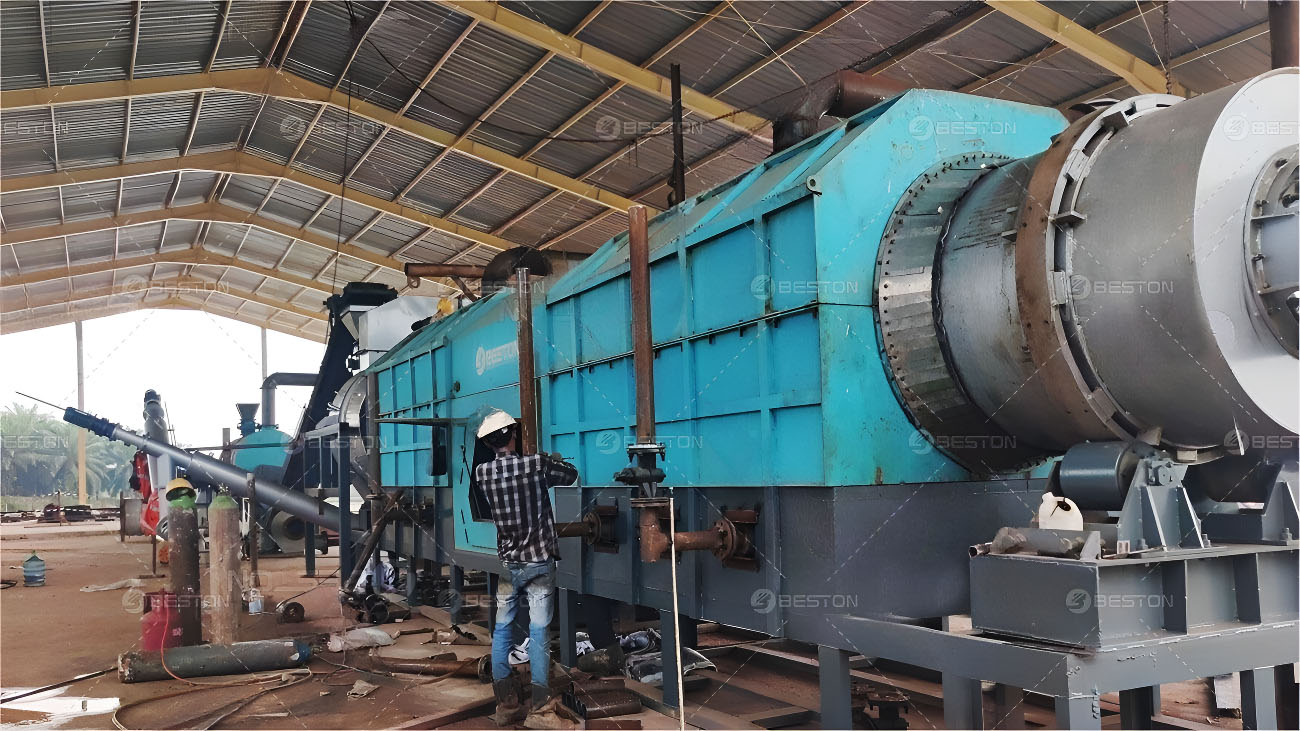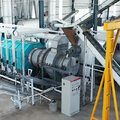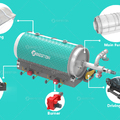In the pursuit of sustainable waste management practices, pyrolysis emerges as a frontrunner in addressing the challenge of agricultural waste biomass. Leveraging advanced technology and scientific principles, biomass pyrolysis plants offer a comprehensive solution for converting agricultural residues into valuable resources while mitigating environmental impact. Let's delve into the intricacies of pyrolysis and its role as the best solution for agricultural waste biomass recycling.
Understanding Pyrolysis
Pyrolysis is a thermochemical process that involves the decomposition of organic materials in the absence of oxygen, leading to the production of biochar, bio-oil, and syngas. The process typically occurs at elevated temperatures ranging from 400°C to 800°C, depending on the feedstock and desired products. Biomass pyrolysis plants utilize this process to convert agricultural waste biomass, such as crop residues, straw, husks, and stalks, into valuable bio-based products.
Mechanism of Pyrolysis
During pyrolysis, agricultural waste biomass undergoes thermal decomposition, breaking down into volatile components and solid char. The process consists of several stages:
- Drying: Removal of moisture content from the biomass feedstock.
- Pyrolysis: Thermal decomposition of organic matter into volatile gases, bio-oil, and char.
- Gasification: Conversion of volatile gases into syngas, a mixture of hydrogen, carbon monoxide, and methane.
- Condensation: Cooling of bio-oil vapors to yield liquid bio-oil.
Advantages of Biomass Pyrolysis
Biomass pyrolysis offers several compelling advantages as a solution for agricultural waste biomass recycling:
- Resource Recovery: Pyrolysis enables the conversion of agricultural residues into valuable bio-based products, including biochar, bio-oil, and syngas, which can be used as renewable energy sources or as feedstocks for various industries.
- Environmental Sustainability: By diverting agricultural waste from landfills and incineration, pyrolysis mitigates greenhouse gas emissions, soil degradation, and air pollution, contributing to environmental preservation and climate change mitigation.
- Circular Economy: The production of biochar and bio-oil from agricultural waste biomass closes the loop in the circular economy, promoting resource efficiency, waste reduction, and sustainable development.
- Energy Generation: Syngas produced during biomass pyrolysis can be utilized as a clean and renewable fuel for power generation, heating, and industrial processes, reducing reliance on fossil fuels and mitigating carbon emissions.
- Soil Amendment: Biochar, a stable carbon-rich material produced during pyrolysis, can be used as a soil amendment to improve soil fertility, water retention, and carbon sequestration, enhancing agricultural productivity and resilience to climate change.

Application of Biomass Pyrolysis in Agriculture
The utilization of biomass pyrolysis in agriculture holds immense potential for enhancing sustainability and resource efficiency:
- Crop Residue Management: Pyrolysis offers a sustainable solution for managing crop residues, such as straw, husks, and stalks, by converting them into biochar and bio-oil, which can be used as soil amendments or renewable energy sources.
- Bioenergy Production: Syngas generated from biomass pyrolysis can be utilized to produce heat and power for agricultural operations, including drying, heating, and electricity generation, reducing reliance on fossil fuels and lowering energy costs.
- Soil Health Improvement: Application of biochar derived from biomass pyrolysis improves soil structure, nutrient retention, and microbial activity, enhancing crop yields, resilience to drought and disease, and long-term soil fertility.
- Waste Valorization: Pyrolysis enables the valorization of agricultural waste biomass into high-value products, such as biochar for soil amendment, bio-oil for biofuel production, and syngas for energy generation, creating new revenue streams and economic opportunities for farmers and rural communities.
Challenges and Considerations
Despite its numerous benefits, biomass pyrolysis faces several challenges and considerations:
- Feedstock Availability: The availability and quality of agricultural waste biomass vary depending on factors such as crop type, harvest season, and geographical location, posing challenges for consistent feedstock supply and production scalability.
- Technology Optimization: Continuous research and development are needed to optimize pyrolysis technology, improve process efficiency, and enhance product quality and yields, ensuring economic viability and competitiveness in the market.
- Economic Viability: The upfront capital costs associated with biomass pyrolysis plant and the economics of biochar, bio-oil, and syngas production influence the profitability and financial feasibility of pyrolysis projects, requiring careful cost-benefit analysis and investment planning.
- Regulatory Framework: Compliance with environmental regulations, safety standards, and land-use policies is essential for the permitting and operation of biomass pyrolysis plants, necessitating regulatory certainty and supportive policy incentives for sustainable biomass utilization and waste management.
Future Outlook
The future outlook for biomass pyrolysis in agricultural waste biomass recycling is promising, driven by technological advancements, market demand for sustainable alternatives, and regulatory support for renewable energy and circular economy initiatives. As awareness of environmental and climate change issues grows, biomass pyrolysis is expected to play an increasingly important role in transitioning towards a more sustainable and resource-efficient agricultural system.
Research and Innovation
Ongoing research and innovation efforts focus on enhancing the efficiency, scalability, and environmental sustainability of biomass pyrolysis technology. Collaborative initiatives between academia, industry, and government institutions aim to address technical challenges, optimize process parameters, and develop novel applications for bio-based products derived from agricultural waste biomass.
Policy Support
Supportive policy frameworks, including renewable energy mandates, carbon pricing mechanisms, and incentives for sustainable agriculture and waste management, are essential for accelerating the adoption of biomass pyrolysis and unlocking its full potential in agricultural waste biomass recycling. Government support for research and development, technology deployment, and market development is crucial for fostering innovation and investment in biomass pyrolysis projects.
Market Expansion
As market demand for sustainable alternatives to fossil fuels and conventional agricultural practices grows, opportunities for biomass pyrolysis are expected to expand across various sectors, including agriculture, energy, and environmental remediation. Strategic partnerships, market collaborations, and value chain integration can facilitate market expansion and commercialization of biomass pyrolysis products, contributing to the transition towards a circular bioeconomy.
Conclusion
In conclusion, biomass pyrolysis emerges as the best solution for agricultural waste biomass recycling, offering a sustainable, cost-effective, and environmentally friendly approach to converting agricultural residues into valuable resources. By harnessing the power of thermochemical conversion, biomass pyrolysis plants can unlock the potential of agricultural waste biomass as a renewable energy source, soil amendment, and feedstock for bio-based products, contributing to sustainable development, climate change mitigation, and circular economy goals. With continued innovation, investment, and policy support, biomass pyrolysis has the potential to revolutionize the way we manage agricultural waste and create a more resilient and resource-efficient agricultural system for the future.





